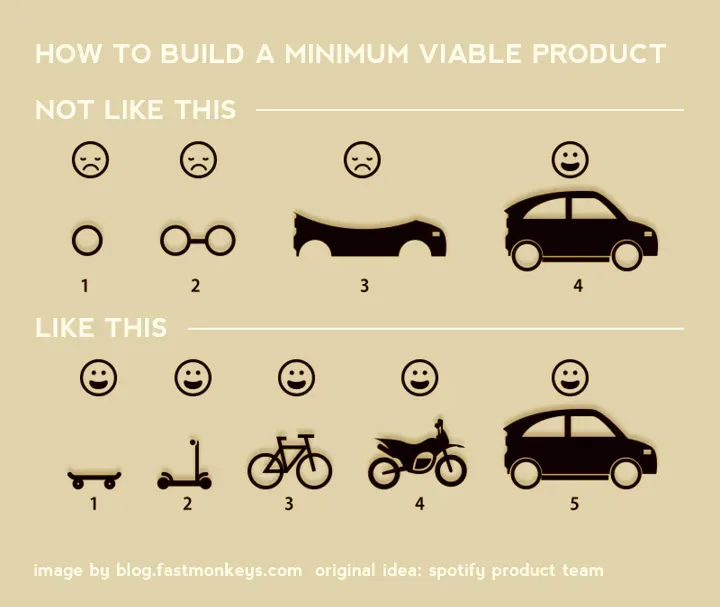Nowadays, people talk a lot about doing business the right way. They put in some thoughts about digitalization and startup bullshit talk. One of those catchy buzzwords is “lean”, “lean startup”, or something similar to this.
The problem is: most people (even most so-called experts) do not really know what lean means, confuse it with doing something stupid and often fuck up. It is okay to fail - but do not fail by being stupid!
What do people think “lean” means?
“‘Lean’ means that we do not discuss everything in detail. We rather just do it and do it step by step. We also do a quick test first to check if there is any market need” - that is how most executives and experts explain it to me.
Some say “lean” is about testing, it is about prototyping, it is about a first Minimum Viable Product (MVP), it is about tipping your toe into the water first, it is about step by step, it is about failing fast and cheap.
This is quite true and false at the same time! All those things describe the concept of lean management, but most people get misled by them.
What the inventors thought of
The idea behind “lean” is indeed, to not discuss everything to death, before even rolling out some first version. It is also a lot about learning and adjusting planning, in order to minimize the risk of wrong investment and focus on what really works and adds value (to you and your customers).
Within product management, you build your MVP, test it right within the market, derive learnings, adjust, repeat.
Basically sounds exactly like the paragraph before, right?
Do not think it is easy
The concept behind “lean” feels simple, but it requires smart actions to do it the right way. Here are some examples of how people do it the wrong way and why it is dangerous.
The Minimum Not Yet Viable Product
The MVP is not about spending almost no money and testing just something! It is about cutting your product vision to the smallest version that is already able to solve the problem of your customer or fulfill the vision somehow. Talking about the MVP, you should always think of your value proposition. If your value proposition is to build amazon, but without product pages, because your AI assistant knows everything: do NOT build a regular marketplace!! You would need to build something that already fulfills your promise. In this case, you could build a first webapp, but use humans instead of the final AI and then test it with customers, telling them that they are talking to a robot. If your value proposition is to be able to calculate how to fly to Mars, your MVP needs to be able to do exactly that! Of course, you could build just some click-dummy and talk to people. Fair enough. You will get some first feedback that already helps you, but you will never really know if your product or just the concept of the click-dummy failed (or won).
Your MVP needs to be viable, not necessarily cheap and fast. Working with very simple prototypes is good for first feedback, but should never be used (without other tests) to decide if something works or not. The MVP should be based on a quick prototype - not the other way round.
One very good (older) article on this: “Your MVP is minimal, but is it viable?”

Failing too fast
“Failing fast” is one common phrase that often leads to misunderstandings. Of course, it is always good to fail rather fast than too late. Many therefore go too fast. They build a prototype, test it with 30 people, get negative feedback, and kill the whole project. This is close to the MVP part. Failing fast is important, but always make sure that you gave the product a fair chance. The more complex the concept and value proposition, the more time you should invest into testing. The same applies to the target audience and business model. If you go for B2C with a EUR 1 product that everybody needs, a prototype test within 1 day with 100 students might already tell you if it works. If you go with B2B and focus on big corporates (no matter the product) it already looks more different - this target audience does not decide within 5 minutes, but often rather 9 months. How can you tell it does (not) work within 1 day, if (in the real world) the audience is discussing the purchases decision with 5 divisions, 4 executives, within 20 meetings over almost a year? You can get a first idea, but is it valid?
Saving on look and feel
Building the MVP (or even prototype), many save on design and UX. They say “it is about functionality, not design”. They are right if they are creating the pill that cures cancer. They more often are wrong, because customers do not only want functionality. They want a cool product. This is especially important, if you do not invent the big bang, but are only evolving something that already exists. As with all other points, it depends on what you are doing - there is no “fits all” concept.
To keep it short
Some people already say, that “lean startup” is dead, because big inventions require huge investments (time + money). They are part of the huge crowd that never really understood what “lean” really means and how to unleash its power. Lean is mostly about your specific vision and business case! This Forbes article here describes it pretty well and if you do not agree with what I wrote above, please read it!
Don’t be lean, be smart!


